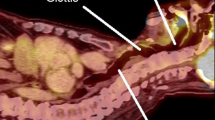Abstract
Purpose
To determine the effect of contrast medium dilution during tracheal balloon dilation on balloon deflation time and visibility using a 3-dimensional (3D) printed airway phantom.
Materials and Methods
A comparison study to investigate balloon deflation times and image quality was performed using two contrast agents with different viscosities, i.e., iohexol and ioxithalamate, and six contrast dilutions with a 3D printed airway phantom.
Results
Compared to 1:0 concentration, 3:1, 2:1, 1:1, 1:2, and 1:3, contrast/saline ratios resulted in a 46% (56.2 s), 59.8% (73.1 s), 74.9% (91.6 s), 81.7% (99.8 s), and 83.5% (102 s) reduction for iohexol, respectively, and a 51.8% (54.7 s), 63.8% (67.6 s), 74.7% (79.2 s), 80.5% (85.3 s), and 82.4% (87.4 s) reduction for ioxithalamate, respectively, in the mean balloon deflation time, although at the expense of decreased balloon opacity (3.5, 6.9, 11.1, 12.4, and 13.9%, for iohexol, respectively, and 3.2, 6, 9.6, 10.8, and 12.4%, for ioxithalamate, respectively).
Conclusions
Use of a lower viscosity contrast agent and higher contrast dilution is considered to be able to reduce balloon deflation times and then simultaneously decrease visualization of balloons. The rapid balloon deflation time is likely to improve the safe performance of interventional procedures.




Similar content being viewed by others
References
Cho YC, Kim JH, Park JH, et al. Tuberculous tracheobronchial strictures treated with balloon dilation: a single-center experience in 113 patients during a 17-year period. Radiology. 2015;277:286–93.
Kim JH, Shin JH, Song HY, et al. Tracheobronchial laceration after balloon dilation for benign strictures: incidence and clinical significance. Chest. 2007;131:1114–7.
Park JH, Kim JH, Song HY, et al. Management of benign tracheal strictures caused by tracheostomy. Cardiovasc Interv Radiol. 2014;37:743–9.
Lee KH, Ko GY, Song HY, et al. Benign tracheobronchial stenoses: long-term clinical experience with balloon dilation. J Vasc Interv Radiol. 2002;13:909–14.
Lee WH, Kim JH, Park JH. Fluoroscopically guided balloon dilation for postintubation tracheal stenosis. Cardiovasc Interv Radiol. 2013;36:1350–4.
Riley SA, Attwood SE. Guidelines on the use of oesophageal dilatation in clinical practice. Gut. 2004;53:1–6.
Wallner O, Wallner B. Balloon dilation of benign esophageal rings or strictures: a randomized clinical trial comparing two different inflation times. Dis Esophagus. 2014;27:109–11.
Ferretti G, Jouvan FB, Thony F, et al. Benign noninflammatory bronchial stenosis: treatment with balloon dilation. Radiology. 1995;196:831–4.
Jacobson S. Upper airway obstruction. Emerg Med Clin North Am. 1989;7:205–17.
McCullough PA, Stacul F, Becker CR, et al. Contrast-induced nephropathy (CIN) consensus working panel: executive summary. Rev Cardiovasc Med. 2006;7:177–97.
Stratta P, Quaglia M, Airoldi A, et al. Structure-function relationships of iodinated contrast media and risk of nephrotoxicity. Curr Med Chem. 2012;19:736–43.
Mogabgab O, Patel VG, Michael TT, et al. Impact of contrast agent viscosity on coronary balloon deflation times: bench testing results. J Interv Cardiol. 2014;27:177–81.
Voeltz MD, Nelson MA, McDaniel MC, et al. The important properties of contrast media: focus on viscosity. J Invasive Cardiol. 2007;19:1–9.
Vano E, Ubeda C, Leyton F, et al. Radiation dose and image quality for paediatric interventional cardiology. Phys Med Biol. 2008;53:4049–62.
De Crop A, Bacher K, Van Hoof T, et al. Correlation of contrast-detail analysis and clinical image quality assessment in chest radiography with a human cadaver study. Radiology. 2012;262:298–304.
Gross BC, Erkal JL, Lockwood SY, et al. Evaluation of 3D printing and its potential impact on biotechnology and the chemical sciences. Anal Chem. 2014;86:3240–53.
Michalski MH, Ross JS. The shape of things to come: 3D printing in medicine. JAMA. 2014;312:2213–4.
Murphy SV, Atala A. 3D bioprinting of tissues and organs. Nat Biotechnol. 2014;32:773–85.
Zopf DA, Hollister SJ, Nelson ME, et al. Bioresorbable airway splint created with a three-dimensional printer. N Engl J Med. 2013;368:2043–5.
Kim GB, Lee S, Kim H, et al. Three-dimensional printing: basic principles and applications in medicine and radiology. Korean J Radiol. 2016;17:182–97.
Waran V, Narayanan V, Karuppiah R, et al. Utility of multimaterial 3D printers in creating models with pathological entities to enhance the training experience of neurosurgeons: technical note. J Neurosurg. 2014;120:489–92.
Acknowledgements
This research was supported by Basic Science Research Program through the National Research Foundation of Korea (NRF) funded by the Ministry of Science, ICT and future Planning (2014R1A2A2A01005857). This research was supported by a Grant from the Korea Health Technology R&D Project through the Korea Health Industry Development Institute (KHIDI), funded by the Ministry of Health & Welfare, Republic of Korea (HI14C0517).
Author information
Authors and Affiliations
Corresponding authors
Ethics declarations
Conflict of interest
The authors declare that they have no conflict of interest.
Ethical Approval
This article does not contain any studies with human participants or animals performed by any of the authors.
Additional information
Min Tae Kim and Jung-Hoon Park have contributed equally to this work.
Rights and permissions
About this article
Cite this article
Kim, M.T., Park, JH., Shin, J.H. et al. Influence of Contrast Agent Dilution on Ballon Deflation Time and Visibility During Tracheal Balloon Dilation: A 3D Printed Phantom Study. Cardiovasc Intervent Radiol 40, 285–290 (2017). https://doi.org/10.1007/s00270-016-1497-9
Received:
Accepted:
Published:
Issue Date:
DOI: https://doi.org/10.1007/s00270-016-1497-9




